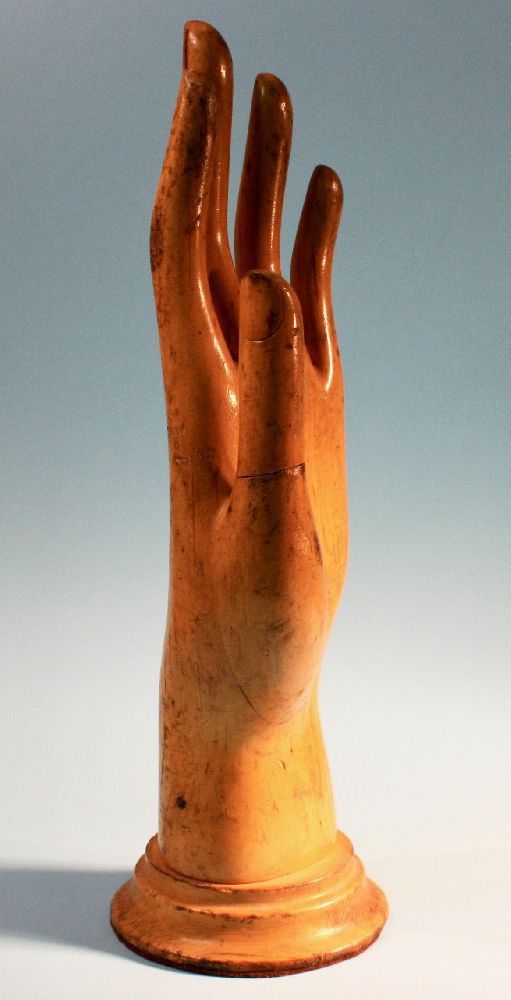

Title: Antique Articulated Wooden Glove Hand Model
Shipping: $25.00
Artist: N/A
Period: 19th Century
History: N/A
Origin: North America > United States
Condition: Museum Quality
Item Date: 1800 to 1900
Item ID: 6743
A rare articulated wooden glove hand Model. For displaying gloves. The Thum is articulated So the glove can slip over the wooden hand easily. It looks to be a French wooden glove mold made from fruitwood. This hand is so well made and designed it looks like a piece of sculpture. Mannequin Hand / 19th and 20th century, an articulated Fashion Display hand model. A glove (Middle English from Old English glof) is a garment covering the whole hand. Gloves have separate sheaths or openings for each finger and the thumb; if there is an opening but no (or a short) covering sheath for each finger they are called fingerless gloves. Fingerless gloves having one large opening rather than individual openings for each finger are sometimes called gauntlets, though gauntlets are not necessarily fingerless. Gloves which cover the entire hand or fist but do not have separate finger openings or sheaths are called mittens. Mittens are warmer than other styles of gloves made of the same material because fingers maintain their warmth better when they are in contact with each other. Reduced surface area reduces heat loss.
Link: https://en.wikipedia.org/wiki/Glove
A Paris corporation or guild of glovers (gantiers) existed from the thirteenth century. They made them in skin or in fur.
During the 13th century, gloves began to be worn by ladies as a fashion ornament. They were made of linen and silk, and sometimes reached to the elbow. Such worldly accoutrements were not for holy women, according to the early 13th century Ancrene Wisse, written for their guidance.[6] Sumptuary laws were promulgated to restrain this vanity: against samite gloves in Bologna, 1294, against perfumed gloves in Rome, 1560.
By 1440, in England glovers had become members of the Dubbers or Bookbinders Guild until they formed their own guild during the reign of Elizabeth I. The Glovers' Company was incorporated in 1613.
It was not until the 16th century that gloves reached their greatest elaboration; however, when Queen Elizabeth I set the fashion for wearing them richly embroidered and jewelled, and for putting them on and taking them off during audiences, to draw attention to her beautiful hands. The 1592 "Ditchley" portrait of her features her holding leather gloves in her left hand. In Paris, the gantiers became gantiers parfumeurs, for the scented oils, musk, ambergris and civet, that perfumed leather gloves, but their trade, which was an introduction at the court of Catherine de Medici, was not specifically recognised until 1656, in a royal brevet. Makers of knitted gloves, which did not retain perfume and had less social cachet, were organised in a separate guild, of bonnetiers who might knit silk as well as wool. Such workers were already organised in the fourteenth century. Knitted gloves were a refined handiwork that required five years of apprenticeship; defective work was subject to confiscation and burning. In the 17th century, gloves made of soft chicken skin became fashionable. The craze for gloves called "limericks" took hold. This particular fad was the product of a manufacturer in Limerick, Ireland, who fashioned the gloves from the skin of unborn calves.
Embroidered and jeweled gloves formed part of the insignia of emperors and kings. Thus Matthew of Paris, in recording the burial of Henry II of England in 1189, mentions that he was buried in his coronation robes with a golden crown on his head and gloves on his hands. Gloves were found on the hands of King John when his tomb was opened in 1797 and on those of King Edward I when his tomb was opened in 1774.
Pontifical gloves are liturgical ornaments used primarily by the pope, the cardinals, and bishops. They may be worn only at the celebration of mass. The liturgical use of gloves has not been traced beyond the beginning of the 10th century, and their introduction may have been due to a simple desire to keep the hands clean for the holy mysteries, but others suggest that they were adopted as part of the increasing pomp with which the Carolingian bishops were surrounding themselves. From the Frankish kingdom the custom spread to Rome, where liturgical gloves are first heard of in the earlier half of the 11th century.
When short sleeves came into fashion in the 1700s, women began to wear long gloves, reaching halfway up the forearm. By the 1870s, buttoned kid, silk, or velvet gloves were worn with evening or dinner dress, and long suede gloves were worn during the day and when having tea.
In 1905, The Law Times made one of the first references to the use of gloves by criminals to hide fingerprints, stating: For the future... when the burglar goes a-burgling, a pair of gloves will form a necessary part of his outfit.
Early Formula One race cars used steering wheels taken directly from road cars. They were normally made from wood, necessitating the use of driving gloves.